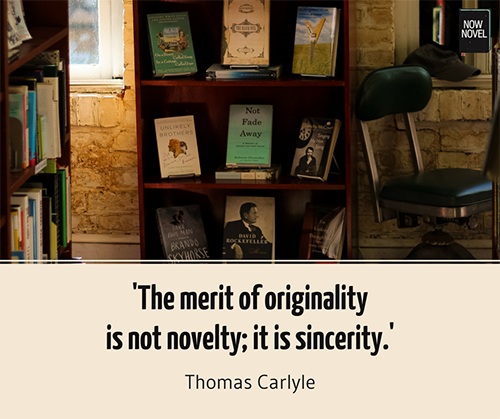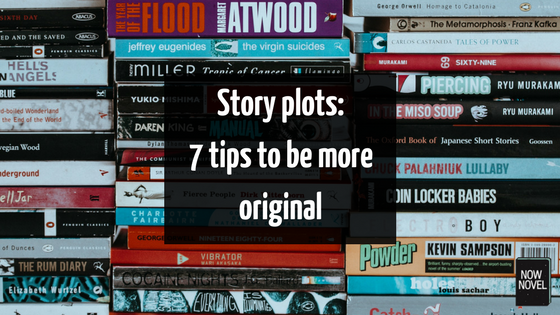Clichéd story plots weaken an otherwise good story, a story where characters and settings are vivid. To tell a story that feels original and inventive, it’s key to learn plot clichés to avoid. Yet many original stories do use common tropes. The key is to make famous story types and scenarios your own:
1: Know common plot clichés within your genre
In story plots, clichés are frustrating because they’ve been hollowed out of their dramatic impact through overuse. Dragons that go on rampages overpopulate fantasy worlds. Women in distress who need men to save them overpopulate romance novels.
Here are a few more common plot clichés:
- The chosen one: A character has been selected for a task but there’s no backstory or explanation why only this person in particular is capable
- It was all a dream: Strange things happen but turn out to be dreams (often solving plot complications a little too conveniently for the author)
- Representative of another culture gives clueless protagonist profound wisdom: Another example of a common plot cliché, especially in books from earlier times that either romanticized indigenous people or portrayed them as savages (this example courtesy of Strange Horizons)
In each of these examples, there is either a cop-out or an overused trope (a ‘trope’ is a literary device that occurs across multiple novels by various authors).
In the first example, there is nothing to explain what is so special about ‘the chosen one’. J.K. Rowling avoids the cliché of ‘the chosen one’ in Harry Potter by giving Harry a past link to the villain that explains exactly why it is he in particular who must fulfill the challenge.
In the ‘it was all a dream’ plot, there is always a risk of a cop-out. The revelation that characters have been dreaming can seem too trite or tidy an explanation for bizarre or puzzling events.
The third example is a plot point rather than an entire story idea. But it tells something valuable about being original: It’s better (for creative as well as political reasons) not to simply repeat received, dominant ideas. Stereotypes are the footmen of unoriginal stories and dangerous politics. The ‘exotic’ foreigner (or indigenous other) is likely to be just as full of flaws and folly as a protagonist. [Writing believable characters is key – get our comprehensive guide, including handy exercises, here.]
So how do you write original story plots? One approach is to combine familiar elements into something new:
2. Combine the familiar to make something original
The dragon that terrorizes a town is a fantasy cliché. Another cliché, like the dream explanation mentioned above, is where everything turns out to be imaginary.
What happens if you combine these two ideas, however? Then things start to get interesting.
If, for example, an inhabitant of the dragon-struck town in the above example investigates the lair, perhaps they could find clues suggesting there is no dragon at all. The dragon could turn out to be a metaphor for a self-created terror striking fear into the town from within.
Suzanne Collins, author of The Hunger Games, said the idea for her series emerged while she was channel-surfing. She saw footage of people competing for a prize on one channel, and people fighting in a real war on another. The two combined in her mind’s eye. This resulted in her story of a society where there are compulsory fights to the death between young people.
Take the same approach to combining different plot ideas. See what creative energy you can unleash when you combine different scenarios or tropes and give them your own unique spin.

3. Know the 7 basic story plots and avoid their most unoriginal tendencies
In The Seven Basic Plots by Christopher Booker, published in 2004, Booker defines the seven basic plot types. Summarized, they are:
- Overcoming the monster: Hero overcomes monster/bad guy
- Rags to riches: The main character rises to success
- The important quest: Character (or group) goes on a crucial mission
- Homeward bound: Adventurer travels, has life-changing experiences and returns
- Comedy: Chaos and confusion give way to resolution
- Tragedy: Characters pay the cost of having flaws
- Rebirth: Character emerges transformed from a process of self-discovery
Each of these plot types has its own pitfalls to avoid if you want your story plots to be original.
In a quest story, a hero might typically have a trusty sidekick who shows surprising bravery (like Samwise Gamgee in The Lord of the Rings).
In a rags to riches story, the heroine might get everything she’s ever dreamed of: The home, the handsome prince, the happiness.
Think of how you can make these story types less clichéd. In a story where a hero faces a villain, for example, you could show the ‘bad guy’ in the hero and humanity in the villain. (J.K. Rowling does this with Tom Riddle’s backstory, his path to villainy, in her Harry Potter series.)
In a ‘rags to riches’ story, a resolution that is bittersweet will surprise readers who expected a tidy but predictable wrap-up.
A path from plot point A to C via B can feel unoriginal and predictable. So how do you take common story plots and make them your own?
Gather great ideas for your plot
Work through easy, structured prompts to outline your story in easy steps.
START
4. Vary a familiar plot with unexpected subplots
Take the common ‘chosen young man is destined to encounter a great evil’ plot type. This would be boring if the progression to the final conflict felt very linear. This is where subplots help you craft familiar source material into something more personal and compelling.
In J.K. Rowling’s YA fantasy series, for example, Harry is on a path to a final conflict, and is a ‘chosen one’. Yet Rowling’s setting – a school for witchcraft and wizardry – allows for all kinds of subplots and smaller story arcs and tensions. The daily life of school, complete with conflicts between teachers and students and budding romance, makes the story zigzag towards its end and avoid overemphasizing the more clichéd elements of the plot (such as a central villain seeking immortality).
5. Be guided by original novels within your genre
One of the big traps for aspiring writers who want to be original is confusing genre clichés with genre necessities.
Your fantasy world doesn’t necessarily need to have warring kingdoms (though this can be given your own unique take). Your romance novel doesn’t have to star the wealthy millionaire who sweeps broke, plain Jane off her feet.
To be more original in your own writing, do some digging to find out what novels in your genre are considered particularly original. Read a few and ask yourself:
- What familiar genre elements (e.g. warring kingdoms or a suave, eligible millionaire) does this book use?
- How does the book make these elements feel less clichéd? What complications/surprises/differences make it stand out from other books that follow similar plot lines?

Think about what your readers’ expectations for your particular plot type might be and actively plan how you will surprise them:
6. Thwart the reader’s expectations and preconceptions
Story plots are original when:
- The story belongs to a specific genre (e.g. romance) but doesn’t follow all our expectations (e.g. the lovers don’t end up together in the end)
- The expectations set up by certain tropes (e.g. Chosen boy has important quest) aren’t fulfilled exactly the way we expect (the goal of the boy’s quest changes with a major plot development, for example)
Plan how you will subvert or alter standard details of your genre (be it the trusty sidekick or the devious villain).
7. Don’t try too hard – ‘unlikely’ is not a synonym for ‘original’
Even though originality makes a story memorable, repetition is one of the satisfying elements of storytelling. A story that contains familiar elements lets us place it within a specific context and heritage.
Focus on how you can harness familiar story ideas to your own ends, rather than make your story absurd simply for the sake of originality. The truth ultimately is that fiction is most original when you express your personal, unique combination of perspective, passion and interests in your writing.
Find and finesse the central idea for your story now using the Now Novel idea finder.


12 replies on “Story plots: 7 tips to be more original”
I took the concept of women who run screeching and helpless from monsters–bigfoot, dogmen, UFOs, or other offensive, smelly things–and turned it around. What if a tiny woman actually confronted many, and one really big one? And won? (Now that AIN’T punny.)
I took the concept of spooky, mystical American Indians, (” I saw you in a dream my son. You were drinking from a spring that came from the nose of an animal I didn’t recognize. It had two great horns, one on each side of its nose, and the water that came from its nose was full of air!) and wrote them as guy-next-door people. The children play Red Rover, Red Rover and jacks. They skip rope. Some of them sing in the town’s boys choir. And not one of them has a vision or a dream. They get diabetes and gamble at their own casino. They are not drunk sad sacks, and not one of them rides an Indian pony without a saddle. Some of them go to church, and at least 45 or so belong to their little community Southern Baptist church. And, in history, the tribe’s Red Sash warriors and other men rode hard to help the Cheyennes the day that damned Custer and his damned 7th Cavalry attacked Black Kettle’s camp on the Washita river, but did not participate in the battle because they arrived too late. At the time of the story, the Aransa Tribal Council has passed a resolution that decrees that a state of war still exists between the Aransa and the 7th Cavalry. And the most beautiful girl in the book is one of the community young women, who goes on to become the reigning Miss World Leader and associate director of the Chingdu, Sichuan, China symphony orchestra.
But, alas, the bigfoots are all sterotypical, smelly, and some of them do try to snatch children away from their families.
Sounds fascinating Jim.
It’s true, absolutes are risky (#notallbigfoots?)
I love this. Could not wait to read it when it hit my inbox this morning.
Funny though, how I was only thinking similarly not five minutes prior to receiving your email.
Thanks for continuing to inspire and help polish my knowledge and craft.❤️
Thanks Debi! It’s a pleasure, thank you for reading.
Very intersting article. I think that storytellers will always use the same elements and structures in a story, because that’s how it makes sense. Going after originality at all costs isn’t always a good idea. But I like your suggestion to combining different common ideas or looking at a common ideas in a new way.
I don’t think we’ll never produce original ideas in storytelling, but I do think there are countless ways to tell the same story and give it a different meaning every time.Every storyteller has something to tell, something that comes from within them and belong to them alone. That’s the biggest originality of all.
You are so right about the last point, JazzFeathers. I fully agree!
Excellent recommendations. I find it difficult to veer from the main plot to smaller ones.
Thank you, Ger. It can be challenging to do so and not lose sight of the main strand. It’s often helpful to brain storm subplots that support your main story event and choose between those that illustrate your characters’ personalities, goals and motivations best.
The story falls within a specific genre (e.g. romance) but doesn’t follow our expectations (the lovers don’t end up together in the end). – This could simply lead to the rejection of the book, no matter how well it was written, so I don’t think it is a good advice, while I agree with all others. Sometimes originality has a price…
That’s a fair perception, Elena. Although the indie movie ‘500 Days of Summer’ ended with the romantic leads not ending up together. The way the scriptwriters resolved this was by having the male romantic lead meet someone new right at the end. If the book is well written and an enjoyable read, publishers may look past some unconventional elements. It does also depend on the publishers. Harlequin, for example, has more fixed plot formulae they prefer.
I enjoyed this post so much I have put together an infographic to remind me.
https://uploads.disquscdn.com/images/e2e1b60b69b9c7500c611afa6dbb71d9de621505740c2583dbab7f68a1ed3f76.jpg